Text
I don’t think I’ve posted about my pet turtle on here yet but I’m out of content and about to go on vacation so here she is

Her name is Donut (named by my sister) and she’s a juvenile Red-Eared Slider! She is the love of my life and she hates me
4 notes
·
View notes
Text
Red-Eared Slider
Sharks are scary
(Source)
3K notes
·
View notes
Photo
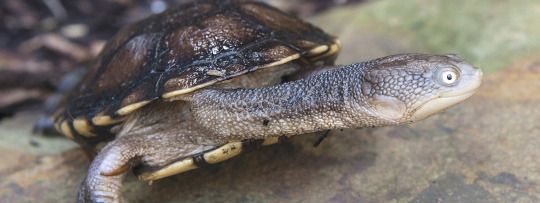
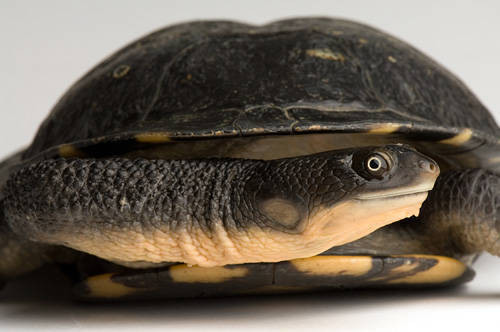
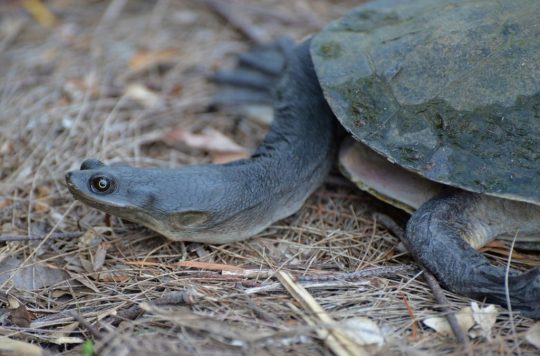
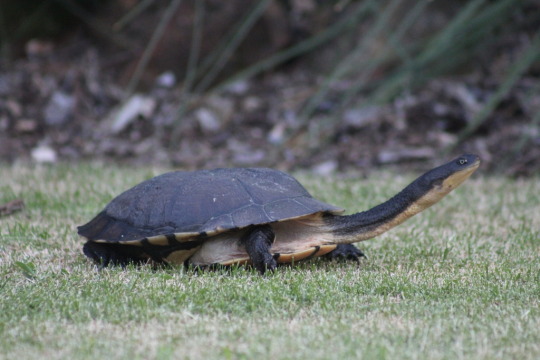
Get Along with the Eastern Long-necked Turtle
For my birthday, I’d like to focus on one of my favorite species: the eastern long-neck turtle (Chelodina longicollis). True to their name, they’re native to eastern Australia where they reside in a variety of habitats, including wetlands, streams, rivers, and dammed waters. In the winter when they become dormant– a period known as estivation– they can also be found under logs or leaf litter.
C. longicollis gets its common name from its unusually long neck, which is over half as long as its shell. Because of its length, the eastern long-neck turtle does not pull it directly back when threatened, but rather tucks its neck to the side for protection. The shell reaches about 28 cm (11 in) in length; the top is dark brown, but the underside has a distinctive orange and black pattern which varies from individual to individual. On average these turtles weigh 6 kg (13 lbs), although females are generally slightly larger and have a shorter, fatter tail.
The long neck of this species is useful primarily for finding food. The eastern long-neck turtle is carnivorous, feeding on aquatic invertebrates, fish, crustaceans, tadpoles, and carrion. Occasionally they also feed on terrestrial animals, mainly small amphibians and rodents. C. longicollis is an ambush predator, and its long neck allows it to strike quickly at prey. In turn, they are predated upon by a variety of animals, including larger lizards, snakes, birds of prey, foxes, and dingoes. The turtle’s shell provides an effective defense against these predators; in addition, individuals can emit a foul-smelling fluid from musk glands located near the base of the tail.
The eastern long-neck turtle is solitary. Individuals have large home ranges, and will frequently move when conditions become unsuitable. Territories can overlap, especially during the breeding season, which occurs from September to October. Males travel long distances to find females, and will often mate with more than one. Females lay their eggs from October to December in clutches of 8 to 24, in nests close to the water. The eggs take about 120 days to hatch, after which they are completely independent. Sexual maturity takes longer to reach than for other species; most individuals are only ready to mate at 7 to 12 years old, and can live up to 30 years in the wild. However, many hatchlings die long before then due to predation and high competition with other turtles.
Conservation Status: The IUCN has not evaluated the eastern long-neck turtle, although due to its large population and range it is considered Least Concern. Primary threats include habitat loss and predation by invasive red foxes (Vulpes vulpes)
If you like what I do, consider leaving a tip or buying me a kofi!
Photos
Rosie Nicolai
Joel Poyitt
Peter Storer
Joel Sartore
882 notes
·
View notes
Text
Galápagos Tortoise
Fuck you *migrates to another environment and evolves entirely new characteristics over thousands of years*
16K notes
·
View notes
Note
I believe this is a Three-Toed Box Turtle.



First day back home and found another turtle🥰
Awwww, little fella is shy <3333
5 notes
·
View notes
Text
So sorry about missing World Turtle Day, I was busy with school 😔 y’all can put me down if you want
0 notes
Text
Ey so I am officially transferring all the stuff from my old laptop to my new laptop, and if you've ever had to do that you know that it's a very long and involved process, so in leiu of Friday's normal post (and since it's World Turtle Day) I'm just going to be reblogging all of my old turtle posts. Please give them as much appreciation as they deserve on this most holy of holidays.
And in the meantime, please enjoy this home-grown meme (no i'm not salty about conservation focus, why do you ask?)

928 notes
·
View notes
Text


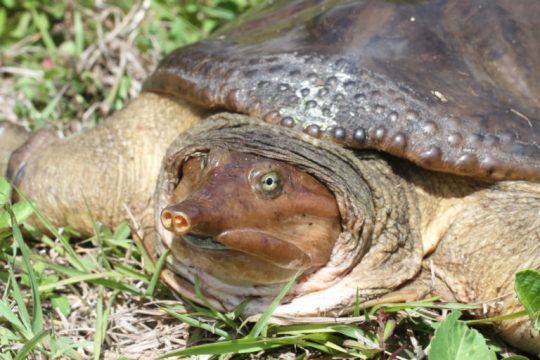
Feeling Out the Florida Softshell Turtle
The Florida softshell turtle (Apalone ferox) is a species of softshell turtle that resides only in the southeastern tropics of the United States, especially along the Atlantic Coast and the Gulf of Mexico. Within this range, they can be found in a number of freshwater environments, including ponds, lakes, swamps, marshes, and urban catchments; they may occasionally also occur in the mouths of slower moving rivers and streams. They generally prefer more muddy bottoms, in which they can bury themselvesand forage for food.
Florida softshell turtles have a highly varied diet, obtained through both active predation and scavenging. When hunting, they may bury themselves at the muddy lake bottom and wait for potential prey to come close enough for an ambush. They are largely carnivorous, feeding on fish, insects, crustaceans, frogs and mollusks, as well as the occasional aquatic plant. Adults are primary predated upon by alligators, while juveniles and eggs may fall prey to foxes, raccoons, birds, and large fish.
Although A. ferox is almost entirely aquatic, adults will readily move overland to find more suitable habitat. They are also frequently spotted basking on rocks or logs. Adults are highly aggressive, and will attack anything they percieve as a threat, including birds, fish, other turtles, and people. In addition to their ferocious bite, they also emit a foul-smelling musk to drive away potential predators.
Mating for the Florida softshell turtle occurs once a year, in the spring from March to July. After mating, females lay their eggs along river or lake banks in clutches of 9-24 eggs. Although they only mate once, females may lay anywhere from 2-7 clutches in a single year. Each clutch incubates for 56 to 80 days, and are immediately independent. Males reach maturity at only 2 years old, while females take 5-8 years; both sexes may live to be over 20 years old in the wild.
Although perhaps not the most attractive turtle, the A. ferox has a very striking appearance. They have a large, flattened body which is covered-- limbs and shell both-- in leathery, olive green or brown skin, with a lighter underside. The shell may also sport darker spots, which help the individual blend in to the muddy substrate. The head is specially distinctive, with a long neck and flattened skull, terminating in a pointed, tubular nose. Individuals may use their extended nostrils to breathe without exposing their body above water. Female Florida softshell turtles are much larger than males; 40.1 cm (15.8 in) in length and 6.65 kg (14.7 lb) compared to only 35 cm (14 in) and 2.68 kg (5.9 lb).
Conservation status: The Florida softshell turtle is considered Least Concern by the IUCN. However, they are threatened by harvesting for meat and the pet trade, as well as habitat loss.
If you like what I do, consider buying me a ko-fi!
Photos
Andrea Westmoreland
Paul Cools
J.D. Willson
161 notes
·
View notes
Text
Yellow-Bellied Slider

In the function, looking at a turtle 
4 notes
·
View notes
Text
Box Turtle

One of the turtles at my work has been in quarantine in a dog pool for her eye infection, but she likes looking out of the porthole.
373 notes
·
View notes
Text
Red-Footed Tortoise

5 notes
·
View notes
Text
Juvenile Alligator Snapping Turtle
“No man is an island” oh really? Really? What about him?:

121K notes
·
View notes
Text
Sulcata Tortoise
149K notes
·
View notes
Text
I wish every turtle who must cross a road a very safe journey.
I saw a box turtle crossing a highway this morning and my heart dropped. It’s that time of the year again.
If it’s safe for you to help a turtle cross the road, make sure to move them in the direction they were already going in.
If it’s a snapping turtle only touch the back 1/2 or 1/3 of its shell, you can pinch the carapace above their legs or put one hand on the plastron and one on the carapace (like a pizza box). Just don’t grab behind their head, not all snapping turtles are alligator snapping turtles and that’s a good way to lose a finger.
If you find a turtle on the side of the road that has been hit (even if it appears dead) please note your coordinates and check for local rehabbers. Turtles will survive things that no animal should. Even if it’s not survivable, they will stay alive and suffer a gruesome death without someone to help them go peacefully. Sometimes they look dead but aren’t. Either way, if you can bring them to someone to check them out and help, it’s worth it.
Turtles are too good for this world man. Please help keep them safe
2K notes
·
View notes
Text
Sulcata Tortoise

42K notes
·
View notes
Text
Green Sea Turtle










Some of the wildlife that I saw when swimming on Ningaloo Reef and surroundings. Thanks to Coral Bay Ecotours and Louis Richter or the amazing swim and all the photos!
12 notes
·
View notes
Text
Loggerhead Sea Turtle



look at this diva
12K notes
·
View notes